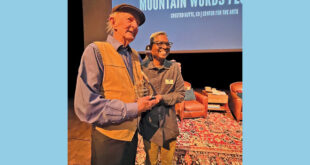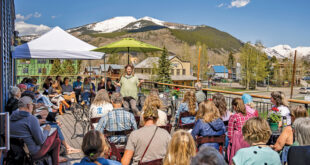Jeff Neumann is fixing a piece of wood to his historic Gunnison home, repairing the board and batten siding in preparation for repainting. He explains that the Denver Rio Grande railroad once ran behind the house in what is now the alley of the north Gunnison neighborhood and the building itself was once the ticket office, or possibly the milk house where they loaded up the train with dairy product for distribution to other areas.
On the porch soaking up the hot late July sun is a small, fragrant jasmine tree in bloom that travels with Jeff and his wife, Martha, on their seasonal RV trips back for winter in Arizona. But with summer in its full glorious green, Jeff is more than content to be in his elevated, cooler valley that he has called home since 1977 when he first moved to Crested Butte. Now in Gunnison for most of the year, he adores his neighborhood because, “The streets are wide, the lots are big and,” he smiles, “it’s pretty quiet with not too many cars going by.” And “quiet” seems a far cry from his lifetime of working around whirring, clanking, buzzing machines in the old days of the printing press, the tools of his chosen career.
As a native of Denver, Jeff grew up hiking, fishing and hunting with his parents around the Fort Collins area in the Poudre canyon. His folks were also in the printing business, running a label manufacturing company. When Jeff was five years old, the family moved to Rangely, Colo. for a couple of years, where his father started The Rangely Driller newspaper, which catered to the oil-producing town. It was Jeff’s first foray into the news and printing industry, watching the newsprint roll off the machines. His dad would take him into the darkroom where he got to watch the photos magically develop.
At 14, he landed his first after-school job delivering menus all over Denver on his scooter. He learned to print on hand-fed snappers, or Platen presses. “You’d have to feed and print each individual sheet of paper by hand,” he explained of the old press technique. He graduated from Hinkley High School in Aurora in 1967 and went right to work at a print shop in downtown Denver. “It was offset printing, all photographically done, making plates from a negative film print. After doing the paste-up, which was a cut and paste process, the plate was made from that and would then go onto the press,” he says of the multi-step, time-consuming and obsolete craft.
Jeff left Denver for Los Angeles during the summer of love in 1967, where he got a job doing plastic injection molding, “It was just a good opportunity to have a job. I did the maintenance on the machinery, cleaning and changing the molds, and setting them up. I loved machines. I like the way they work. One piece working with another is cool.”
He ended up in Venice where he met Martha, who was also from Colorado. After dating, they decided to drive his ‘51 Chevy pickup to Aspen, living out of the back of that truck for three weeks until they found employment. They eloped in Delta in 1969.
During the summer of ‘69 Jeff was working at a print shop called Printed in Aspen and recalls, “Nobody wanted to hire hippies back then and Aspen knew they [hippies] were coming. I don’t know if they ever showed up but we had a great summer and I got right to work on the Heidelberg presses. It was such great work. We were doing a lot of the programs and tickets for the operas and the Aspen Music Festival. It was a lot of fun because they’d always give you a bit of creative license to do the printing if you had ideas for colors, paper, or different ways to make it look good. I did work for Hunter S. Thompson, printing the Aspen Wall Posters that he created, which was a Hunter S. Thompson editorial.
One side would have a silkscreen print of various images, like a badge when he ran for sheriff; the other side would be his editorial opinion. All this happened in the Aspen Times building, which also housed KSNO radio, the Times, Climbing Magazine and our print shop. There were a lot of fun people working in that industry.”
Jeff and Martha discovered Crested Butte after a hike over from Aspen in 1977. “There was this sleepy little town in July and the tin roofs were gleaming and our first view was from the ski area looking down valley. It struck us.” They started traveling to Crested Butte more, and then they started skiing here, even though 1977 was the infamous “Year of UN,” when no snow fell to cover the slopes. Still, the couple decided it was the place they wanted to be.
“We wanted to start a print shop, have a little house in town, start a family and have a golden retriever. We got the dog Russell right away, our daughter Sarah was born in June 1978, and our son Tyler came along in 1982.” They cashed in everything they had in Aspen and bought the little yellow house on Maroon Avenue.
“Selling everything we had in Aspen, we had enough for a down payment in Crested Butte and enough for a duplicator and a copy camera to start the business,” which was Crested Butte Printing. “It was a small town, the streets were dirt but I got really busy quickly,” Jeff reminisces to a time when town had fewer than 500 residents. “We started doing work for the ski area. We kept adding equipment in our little shop, which was in my barn behind my little house. The first year the equipment was sparse, but we did great things,” he smiles.
By the second year they invested in a Heidelberg press, punching the door out of the shop so they could move the enormous machine in. Now able to print larger formats and in color, they started the Crested Butte Magazine in 1978. With orders rolling in, they expanded their workspace by popping the roof on the log barn with a side addition.
“The Crested Butte Magazine was the first magazine of Crested Butte and the talent around town was incredible,” Jeff says. “The photographers, writers, graphic arts people, they were all right there in town and came out of the woodwork and all contributed.” Morgan Queal was the first editor of the Crested Butte Magazine, and after four years, Sandy Fails took up the reins as editor. “She’s got a real good feel for what’s going on Crested Butte,” Jeff says of the magazine’s long-time editor, who is still at the helm today as the magazine celebrates its 40th birthday.
“During all this time, we were skiing, shoveling snow, fire fighting, printing and parenting,” Jeff recalls of their full life. “I started hunting again and one time we got this elk late in the day. It was snowing and we were on Kebler Pass. We took it into the print shop to dress it because it was the only place we had. We skinned and quartered the elk in there. We had it all draped off and we had concrete floors but it kicked up so much humidity in the air that it affected the paper and threw the job we were doing out of register. We had to redo the entire job.” Jeff beams that he’s missed his elk only twice since 1987.
Before Jeff was even settled in town that first year, he knew he wanted to be part of the Crested Butte Fire Department. “I really wanted to drive the fire truck—it’s every little boy’s dream and with arms open wide, they said, ‘Come on over—we’ll show you how to drive that fire truck.’ Once I joined, I became a fire fighter and operator of the truck,” he grins like a little boy and proudly adds, “and then captain and then chief.” He was an active fire fighter for 20 years and on the board for 15 years. All in all, Jeff was with the department from 1977 to 2006.
As both their business and family grew in the early 1980s, they took the next step. “Now the house wasn’t big enough so we had to pop the top on the house to make room for a family. Life got better. We were getting even busier with printing so we had to trade in the old Heidelberg for a newer one, which allowed us to do larger format printing jobs. The Heidelberg could print only one color at a time; you started with magenta, then yellow, blue and then black. Each sheet had to be perfectly registered all the time. When the orders kept getting bigger, we bought a shell of a building on Belleview in 1985 [now the location of Adaptive Sports] and expanded it. Then we bought a four-color Heidelberg. We were publishing the Crested Butte Magazine as well as the Montrose Anytime Magazine, Ouray Magazine for their chamber of commerce, and we were doing a lot of work out of Aspen as well as Obermeyer ski clothing, Gay Ski Week, brochures for the chambers in Delta, Gunnison and Crested Butte. Back in 1985 when I was doing all the different magazines, we were producing books as well for our company. In 1989 we published Crested Butte: the Edge of Paradise, doing four printings. In 1993, we did Seasons of Paradise, which was a soft-cover coffee table book as well. These were all produced with our own writers, photographers and printing. Sandy Fails did the Crested Butte books with Nathan Bilow as photographer.”
Jeff and Martha sold Crested Butte Printing and the magazine in 1999. “It just felt like the right time to sell. I had been in the printing business and pressroom for 30 years. I was ready to get out. There was some traveling I wanted to do and never had time. I wanted to take my boat to the Bahamas,” which they discovered in early 2000s.
Jeff trained for boating at the Chapman School of Piloting in Florida for a week to learn navigation, tides, running inlets, and ocean-going. In 2003, they loaded up their 25-foot Bayliner and motored down the Mississippi River to New Orleans, leaving the boat there for the winter, returning the next spring to boat down the International Coastal Waterway to Apalachicola, Fla., then hauled it overland to Vero Beach and boated to the Bahamas. They’ve made five open-water round trips from Vero Beach to Marsh Harbor in the Abaco Islands.
“I reflect on where I’ve been and where I’m headed and for me it’s being physically active. We love to scuba dive and we’ve done thousands of dives. We take fishing trips to Alaska.”
They moved to their home in Gunnison in 2016, having sold their properties in Crested Butte, and now spend part of their winters scuba diving in Bonaire and also relaxing in Arizona. “I still love Crested Butte and consider it my home, it’s where I grew up essentially. I have a lot of friends there. It’s where I feel I belong. I don’t need to be in the printing business anymore,” he smiles. “I got it out of my system,” he says, emphasizing how appreciative he is of all the support the people showed throughout the decades.
 The Crested Butte News Serving the Gunnison Valley since 1999
The Crested Butte News Serving the Gunnison Valley since 1999





